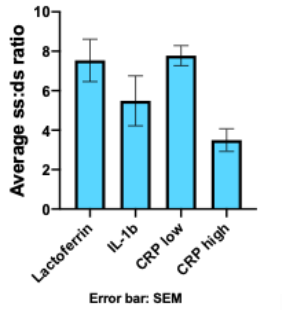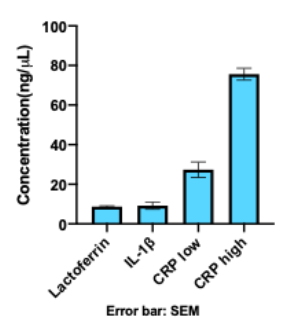Part:BBa_K3724006
IL-1b aptamer
Aptamer for Interleukin-one beta (IL-1β) This part selectively detects IL-1β, with a detection range of 20-1000 ng, as determined in an ELISA-like assay[1]. IL-1β is a pro-inflammatory cytokine, secreted by immune cells such as macrophages and helper T cells. It plays an important role in the innate immune response and thus shows elevated levels in sepsis, cancer and other immune disorders[2,3]
Usage and Biology
Aptamers can be used to detect biomarkers in various body fluids, or to treat certain diseases by selectively inhibiting specific targets and therefore their signaling cascade[4]. Their function is similar to antibodies, but they are much easier to synthesize as they can be made in vitro via PCR.
Sequence and Features
- 10COMPATIBLE WITH RFC[10]
- 12COMPATIBLE WITH RFC[12]
- 21COMPATIBLE WITH RFC[21]
- 23COMPATIBLE WITH RFC[23]
- 25COMPATIBLE WITH RFC[25]
- 1000COMPATIBLE WITH RFC[1000]
Characterization
The aptamer was stored in E. coli inside a pUC-IDT Golden Gate vector with ampicillin resistance. This plasmid DNA was used as template for asymmetric PCR. The first PCR conditions (annealing gradient temperature 48-60°C and forward : reverse primer ratio of 20:1) gave poor results, so we followed up by testing a lower gradient (40-50°C) and forward : reverse primer of 15:1 and 30:1. As shown in Figure 1, darker product bands were obtained at higher forward : reverse primer ratio, and the annealing temperature that gave the best result was around 46°C.
The optimized PCR conditions were 20 cycles of amplification, 2 mM MgCl2 and 46°C annealing temperature. Figure 2 shows how the aptamer ran on 5% agarose gel, which confirms that it was successfully synthesized at the expected length.
To determine the ratio of ssDNA : dsDNA that was synthesized, we used an assay that uses two different dyes, one with high affinity for ssDNA and one with high affinity for dsDNA, and the fluorescence is measured using a BioTek plate reader (Quantifluor assay). The concentration is measured based on a standard curve that was run for each experiment. The average ratio obtained for IL-1β aptamer was 5.5 : 1 (ssDNA : dsDNA, Figure 3).
The ssDNA concentration for IL-1b aptamer, after purifying the product using PCR cleanup kit, is shown in Figure 4.
In both Figures 3 and 4, the results are reported as average of four different experiments.
References
[1] Ho, D.-R., Chang, P.-J., Lin, W.-Y., Huang, Y.-C., Lin, J.-H., Huang, K.-T., . . . Chen, C.-S. (2020). Beneficial Effects of Inflammatory Cytokine-Targeting Aptamers in an Animal Model of Chronic Prostatitis. International journal of molecular sciences, 21(11), 3953. https://doi.org/10.3390/ijms21113953
[2] Bozza, F. A.; Bozza Pt Fau - Castro Faria Neto, H. C.; Castro Faria Neto, H. C., Beyond sepsis pathophysiology with cytokines: what is their value as biomarkers for disease severity? (0074-0276 (Print)).
[3] Kaneko, N., Kurata, M., Yamamoto, T. et al. The role of interleukin-1 in general pathology. Inflamm Regener 39, 12 (2019). https://doi.org/10.1186/s41232-019-0101-5
[4] Ho, D.-R.; Chang, P.-J.; Lin, W.-Y.; Huang, Y.-C.; Lin, J.-H.; Huang, K.-T.; Chan, W.-N.; Chen, C.-S., Beneficial Effects of Inflammatory Cytokine-Targeting Aptamers in an Animal Model of Chronic Prostatitis. International journal of molecular sciences 2020, 21 (11), 3953.
| None |




